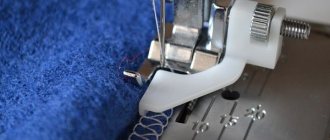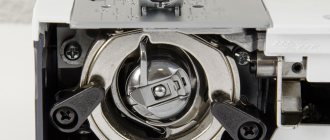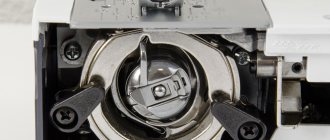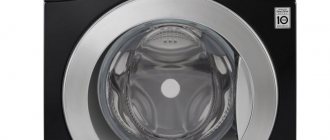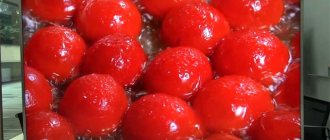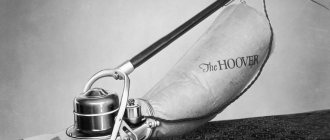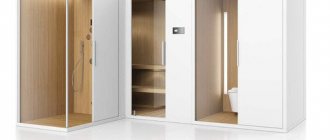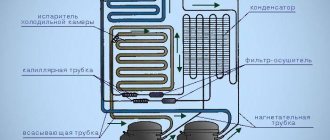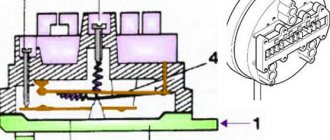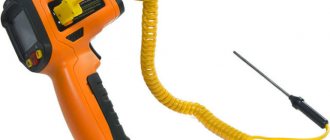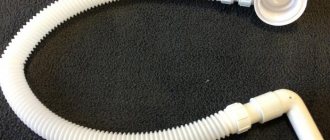What is overlock?
What is an overlocker and what is it for? Overlock refers to the types of sewing machines that are used to overcast sections of any textile materials. This process prevents the stitching of the material from unraveling and gives them a graceful appearance. Wrapping is accompanied by cutting off excess fabric, and some overlockers have a function for stitching product parts, which involves stitching a chain seam. They can perform different types of stitches:
- Classic.
- Decorative.
Overlock image.
Role suture - what is it?
To better understand what it is, it is worth considering any snow-white school bow. Its airy wavy edges are precisely processed with a classic rolled seam.
It inherited its traditional name from English, in which it is called rolled hem (literally “rolled/twisted edge”). The same literal translation from German is rollsaum.
At the same time, historians do not know exactly when and in which country such processing of fabric edges first began.
Rolled hem belongs to the category of finishing seams and can be not only machine-made, but also done by hand. However, like most, it originated from the classic hand loop, albeit slightly modified.
Types of classic seams
You can process the edge of the product using a regular sewing machine, but seams made with an overlocker are much more aesthetically pleasing and of higher quality. It provides for the implementation of 2, 3, 4, 5 thread stitches.
From two threads
Double thread threads are designed for very thin fabrics where you need to use a minimum number of threads. Since overlockers most often require the use of 3 threads per stitch, you need to make sure that this model has a converter. It looks like a special clip that covers the upper looper. To make a 2-thread seam, one needle and one lower looper are sufficient. The needle makes stitches from above, the lower looper is parallel to the bottom, and the upper looper connects 2 lines using a thread spiral. It can be used for fabric with any structure.
Image of a 2-thread stitch.
From three threads
The three-thread stitch is the most common and is performed both on a modern overlocker and on an old one. These are the most economical machines, since if 3 threads are enough for a future product, you can significantly reduce sewing costs. The stitching is done using simple technology.
Image of a 3-thread stitch.
From four threads
Using a four-thread stitch makes it possible not only to overcast the edges, but also to stitch together pieces of fabric. It is most suitable for stitching knitted items. To sew a knitted seam, two needles and two loopers are used. It can be used to process elastic fabrics.
Image of a 4-thread stitch.
Of five threads
Five-thread stitches on modern overlockers are performed with three needles. It can also be done on a carpet stitcher, which has a special lower looper for making chain stitches. It is best used for capricious fabrics, especially where a zipper or a large brooch is provided.
Image of a 5-thread stitch.
Overlock stitch
What should an ideal overlock stitch look like? When is a three-thread and when is a four-thread overlock needed? I ruined everything, what should I do?
We get asked these questions regularly. This means we need to tell you in detail about their types and main defects.
A three-thread or overcast stitch is needed to treat cuts from spillage. It should not be too wide (4-6 mm), because more susceptible to injury than four-thread, which is suitable for thinner fabrics and fabrics that are not prone to severe fraying.
You can find out what the ideal stitch of your overlocker looks like from the description in the instructions or the sample attached to the machine when it was sold.
The upper and lower threads must be tensioned without slack and intertwined strictly at the cut of the material, without interfering with the front or back sides. The needle thread on the right side lies in an even, smooth stitch. On the wrong side, it forms a point buried in the material.
Four-thread stitch with a width of 4 to 9 mm (depending on the overlocker). Along the front side of the fabric there are two parallel needle stitches and a looper thread crossing them across. On the inside there is a looper thread and two rows of dots from the weave with needle threads. They should all be stretched fairly tightly, without any slack. The threads of the upper and lower loopers are clearly intertwined along the cut of the fabric. The stitches are even, parallel to each other.
It is stronger and more functional compared to three-thread. An additional needle stitch secures the cross stitches. With it, it is unlikely that you will accidentally ruin the stitching by snagging and pulling the thread.
Also, a four-thread stitch can serve as a seaming stitch when sewing items from knitted fabrics. For loose fabrics that are prone to shedding, it is also better to use it.
So, the ideal overlock stitch would be if:
- understand the structure of the line and learn how to configure it;
- select high-quality accompanying materials (needles, threads);
- Check the serviceability of the overlocker, the sharpness of the knife, and the lubrication of the machine.
Now let's look at the defects of overlock stitches and how to solve these problems.
First, let's decide on the structure of the overlock stitch and understand how to set it up.
As we have already found out, an overlock stitch consists of three or four threads, two of which are upper and lower looper threads and one (or two) is needle thread. Thread it with colored threads. This way you will see which thread needs to be loosened and which one needs to be tightened using the regulator.
See example in photo 1
blue - upper looper thread;
red - lower looper thread;
yellow - needle thread;
green is the second needle thread for a 4-thread overlock stitch.
⠀
Stitch defects:
⠀– Photo 2: the blue thread is too tight, so the interweaving of the looper threads has shifted to the front side. This means that you need to loosen the tension of the upper looper thread using the overlock adjuster wheel, shifting its value to a lower number.
– Photo 3: the weave has shifted to the wrong side. This means that the lower looper thread tension is too high. Reduce the value.
– The overlock stitch gathers the cut into an assembly (photo 4). This means the needle thread is too tight. We weaken it.
– Photo 5: The yellow needle thread is too loose and needs to be tightened. Move the control wheel towards a higher value.
– Photo 6: The second needle thread is loose. Let's increase its tension.
– In the line in photo 7, the red thread of the lower looper is tightened. She pulls the needle thread and upper looper thread inside out.
⠀
High-quality accompanying materials also play an important role, namely:
Use branded needles, not blunt, no thinner than No. 90 (with rare exceptions). Some knitted fabrics require special ones.
The threads should be of the same density, thickness and on the same bobbins (preferably cone-shaped). Ideal - specialized threads Aerolock madeira. They know how to blend into the fabric, adjusting to the color.
Still not the same? Contact a specialist. He:
- fix a dull knife;
- adjust the tension of the control springs;
- will do a complete debugging of the machine for a sample stitch.
Good luck in mastering your overlockers!
Types of decorative stitches
Modern models of overlockers provide great opportunities for making unique products thanks to several types of seams. These include:
- Role-playing.
- Flat.
- Double sided.
Role-playing
Rolled seam on an overlocker - what is it? In some sources it may be called roller or opiss. To obtain it, manipulations are carried out in which the tensioner in the overlock machine is adjusted. The final result of the finished edge appears to be curled inward. This makes it possible to create a wavy frill. And inserting fishing line into the edge of the skirt will make it elastic. If you use this maneuver to overcast the petticoat, you can get a fuller hem. The rolled seam not only processes the edge of the fabric, but also sews the frills of the suit. This hem is often used when sewing dance costumes. This seam fits harmoniously on decorated parts of tulle and knitwear.
Image of a rolled seam.
A roller seam is performed by reducing the stitch length to a minimum and changing the stitch width. All overlockers have a special tongue located near the needle plate. During sewing, it is positioned so that it is surrounded by the top loop on one side and the fabric on the other. Thanks to this, the edges of the fabric do not curl and the stitching is done in the same width. To obtain a roller stitch, simply remove this tongue. Then you will get a line with a minimum width (about 2 mm), and the edges of the fabric will be curled inward.
Flat
Real flat stitching is done not with an overlocker, but with a cover stitching machine. This is a completely different type of sewing stitch, which is formed differently from the overcast stitch. Some types of overlock machines have a flatlock function. It makes it possible to obtain only a stitch that is visually similar to a flat seam. You can make a real cover seam using carpet lockers. However, the price of such machines is much higher than others, so not everyone can buy them. In this case, you can use an imitation of a flat stitch on an overlock machine.
Image of a flat seam.
The flat type is a decorative function, useful in the process of designing the hem of the lower part and sleeves of the product. It is also suitable for processing cuts on thin fabrics, stitching knitted parts and trimming excess. To perform a stitch, you need to have a special foot designed for this work. Some models come with it right away, while others require a separate purchase. A flatlock seam on an overlocker can be done with two or three threads. Each machine has different capabilities. Stitch parameters may also differ. If the connection is made with the right needle, then the stitch will be narrow, and if with the left, it will be wide.
Flatlock image.
Bilateral
Double-sided seams (also called flat top stitches) can only be made using modernized equipment that allows you to use a large number of threads at once. Threaded threads are intertwined in quantities of 5 to 10 pieces, and thanks to the resulting beautiful stitches, products with beautiful prints are created. Double-sided stitches are not intended for edge stitching; they are used to create decorations for clothing.
Since the overlocker has many capabilities and processes overcast stitches with high quality, in addition to the sewing machine, it is recommended to purchase an additional overlocking device.
Image of a double-sided seam.
Changing the overlock thread tension
After completing all the steps above, sew a test stitch to determine the thread tension. Pay attention to the quality of the rolled seam. If the stitching is uniform and does not tighten the fabric, then leave the thread tension unchanged.
Since the serger blade has been removed, it is very important to position the fabric correctly on the work surface. Align the material along the right edge of the foot. You can also look under the foot: there is a special mark that you can use to guide you.
Let's give a test line. The result should be a thin and neat rolled seam on an overlocker, 1.5–2 mm wide from the edge of the fabric. The following factors will indicate the need to change the thread tension:
- The loops are too loose because there is no normal tension. Normally, they should be pulled together in small knots.
- The thread loops, creating uneven stitches.
In this case, increase the overlock thread tension by one notch and start stitching again. Be careful not to pull the fabric. The seam does not change the elasticity indicators; if configured correctly, the material should stretch well. It perfectly protects the edges of the fabric from fraying and has a fairly aesthetic appearance, so no additional processing of the cuts is required.
Thus, making high-quality stitches is not as difficult as it seems at first glance. You just need to follow the recommendations described above and monitor the quality of the stitching. If the quality of the stitching is poor, you need to check that the thread is threaded correctly. If everything is in order, we adjust its tension.
Tips for choosing seams
The overlock machine has all the capabilities to carry out work that allows maximum maneuverability when creating overcast stitches. When choosing a machine and stitch, keep the following in mind:
- If you buy an overlocker only to overcast edges, then you can limit yourself to a machine that allows you to work with two or three threads. And if you plan to make products with decorative stitches, then it is better to purchase an overlocker with a four-thread overlock.
- The presence of a differential feed option makes it possible to process elastic fabrics and produce assembly elements or flounces.
- Due to the fact that the width of the cut is adjustable, it is possible to make one seam in different versions.
Thanks to the variety of stitches produced by overlocking machines, you can implement any sewing idea and achieve a good result in your design solution. The main thing in this matter is to have a high-quality overlocker that satisfies all the needs of the seamstress.
You can also find out which sewing machines are considered the best.
Features of work
It is incorrect to ask the question about what an overlock is in a sewing machine. She creates an imitation using a simple zigzag stitch. When tensioned, the threads may break. The result is poor quality processing. This is the main reason to purchase a machining machine. But if this is not possible, it is recommended to know the features of working on a machine with such a stitch.
You might be interested in this: How to learn to sew and cut for a beginner
A novice seamstress should know that it is worth processing the edges of products using a foot for these purposes. Each type of stitch is suitable for different purposes. For bed linen, for example, oblique imitation should be used.
Sewing machine with overlock stitch
What can you sew on an overlocker?
Not all needlewomen practice sewing on a home overlocker. Most often, it is used to create bed linen. Perhaps tablecloths and curtains. Therefore, it is difficult to find information on how to sew knitwear using an overlocker for any occasion.
At the initial stages, you can sew pillowcases for fun. And then look at the difference between an overcast seam and a simple one. Draw a conclusion after several months of use. The easiest way to get a knitted set of underwear.
You may be interested in this Instructions for embroidery on T-shirts with examples
Sometimes knitwear can be overlocked
Main types
Let's consider the types of hemming seams, distinguished by the number of coils in the work.
Double thread
Used on materials that need to be handled with extreme care, where the thread count needs to be reduced. The process involves the needle and looper from below. This look cannot be made on conventional models, only with the help of overlockers with converters. The needles that are not involved in the seam are blocked by the converter to free the needles needed for the job.
- How I learned to weld with a welding inverter: personal experience
Three-strand
It is the optimal alternative, which is available on all overlockers, since three-thread stitch is the standard seam. Thanks to it, you can overcast the edges of soft, opaque items. To create additional decor, you can choose a thread that is different in color from the fabric.
Four-strand
To perform it you need to use two hooks and two needles. It is much stronger and denser, although outwardly it is no different from a three-thread seam. It is recommended to use it when processing the hem of long dance dresses or skirts to maintain the durability of the material and a neat appearance.
Five-thread
It is actually a concatenation of two-thread and three-thread stitches, with a cohesive single-thread stitch running through the center. Perfectly useful for high-density fabrics, such as denim.
